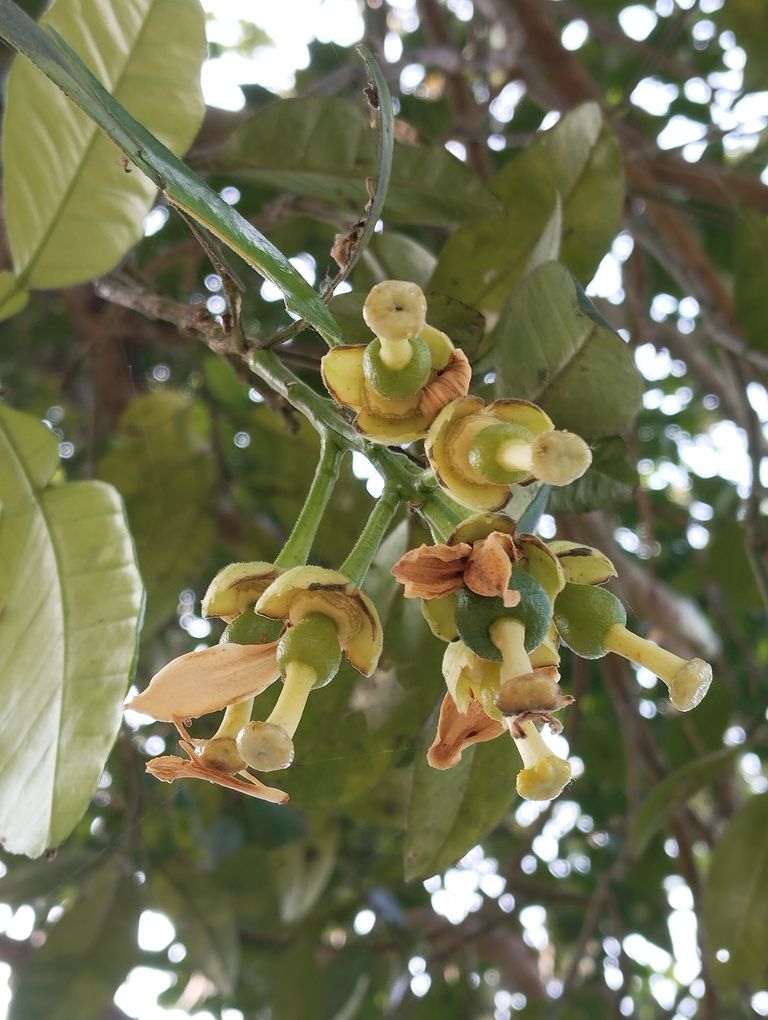
Causes of Flower Shedding in Pomelo Plants.
Pomelo (Citrus maxima), known as "jambura" in many regions, is a highly valued citrus fruit grown for its rich flavor and nutritional benefits. However, one of the common issues faced by pomelo growers is the premature shedding of flowers. This problem directly affects fruit production and can be frustrating for farmers and gardeners alike. In this blog, we will explore the main reasons behind flower drop in pomelo plants and provide solutions to mitigate the issue.
- Nutritional Deficiency
Pomelo plants require a balanced supply of nutrients to thrive. A lack of essential nutrients like nitrogen, phosphorus, potassium, and micronutrients (e.g., zinc, magnesium, and iron) can lead to poor flower health, causing them to drop prematurely.
Solution:
Apply a balanced fertilizer with a focus on nitrogen, phosphorus, and potassium (NPK) in a 2:1:1 ratio during the flowering stage.
Use micronutrient sprays to address deficiencies promptly.
- Water Stress
Both overwatering and underwatering can stress the plant, leading to flower shedding. Pomelo plants need consistent moisture but cannot tolerate waterlogged soil.
Solution:
Ensure proper irrigation during dry periods, especially when the plant is flowering.
Avoid waterlogging by ensuring the soil has good drainage.
- Environmental Stress
Extreme temperatures, whether too high or too low, can cause flowers to drop. Pomelo plants thrive in a warm, subtropical climate, and sudden weather changes can be detrimental.
Solution:
Use shade nets to protect plants from intense heat.
If temperatures drop significantly, cover the plants to shield them from cold winds.
- Pest and Disease Infestation
Common pests like aphids, whiteflies, and citrus thrips can damage flowers and cause them to fall. Fungal diseases like powdery mildew and bacterial infections can also weaken flowers.
Solution:
Regularly inspect the plants for signs of pests and diseases.
Use organic or chemical pest control methods, such as neem oil or insecticidal soap, to manage infestations.
Apply fungicides when fungal diseases are detected.
- Pollination Problems
Poor pollination is a significant reason for flower drop in pomelo plants. This can happen due to a lack of pollinators like bees or unfavorable weather conditions during the flowering period.
Solution:
Encourage pollinators by planting pollinator-friendly flowers nearby.
Manually pollinate the flowers using a small brush to transfer pollen if natural pollination is insufficient.
- Hormonal Imbalance
Flower shedding can also result from hormonal imbalances within the plant. Excessive growth hormones or insufficient flowering hormones may disrupt the plant’s natural reproductive cycle.
Solution:
Use plant growth regulators like gibberellic acid in recommended amounts to balance hormonal levels.
- Pruning and Plant Management
Improper pruning or neglecting regular maintenance can lead to unhealthy growth, which affects flowering.
Solution:
Prune the plant during the dormant season to remove dead or weak branches.
Ensure that the canopy is well-ventilated and allows sunlight to reach all parts of the plant.
- High Fruit Load from Previous Season
If the plant had a heavy fruit yield in the previous season, it might not have enough energy reserves to support healthy flowering and fruiting.
Solution:
Allow the plant to recover by reducing the fruit load in subsequent seasons.
Provide extra nutrients and proper care during the post-harvest period.
Flower shedding in pomelo plants can occur due to a variety of reasons, including nutritional deficiencies, water stress, environmental factors, and pest infestations. Identifying the root cause and implementing targeted solutions can significantly reduce the problem and ensure a healthy fruit yield. Regular monitoring and maintenance are key to keeping pomelo plants thriving.


The Health Benefits of Eating Pomelo (Jambura)
Pomelo, also known as “Jambura” in Bengali, is a large citrus fruit native to Southeast Asia. It is often referred to as the “ancestor of grapefruit” due to its similar taste and texture. Packed with essential nutrients and health benefits, pomelo is not only delicious but also a powerhouse of goodness for your body. In this blog, we’ll explore the various benefits of including pomelo in your diet.
- Rich in Nutrients
Pomelo is an excellent source of vitamins, minerals, and antioxidants. A single serving of pomelo provides:
Vitamin C: Boosts the immune system and promotes healthy skin.
Potassium: Supports heart health and regulates blood pressure.
Fiber: Aids in digestion and promotes gut health.
Additionally, pomelo contains small amounts of calcium, magnesium, and B vitamins, making it a well-rounded fruit for overall nourishment.
- Boosts Immune System
The high vitamin C content in pomelo plays a crucial role in strengthening the immune system. It helps protect the body from infections, reduces inflammation, and speeds up wound healing. Regular consumption of pomelo can lower your risk of colds and flu, especially during seasonal changes.
- Promotes Heart Health
Pomelo contains antioxidants like flavonoids and naringin, which are known to improve heart health. These compounds help reduce bad cholesterol (LDL) levels and prevent plaque buildup in arteries, reducing the risk of heart disease. Potassium in pomelo also aids in maintaining healthy blood pressure levels.
- Aids in Weight Management
If you’re looking for a low-calorie snack to include in your weight-loss diet, pomelo is an excellent choice. The high fiber content keeps you feeling full for longer, curbing unnecessary hunger pangs. Moreover, the natural enzymes in pomelo boost metabolism, helping the body burn calories more efficiently.
- Improves Digestive Health
Pomelo is rich in dietary fiber, which is essential for healthy digestion. It helps prevent constipation, promotes regular bowel movements, and improves overall gut health. Including pomelo in your diet can alleviate common digestive issues like bloating and indigestion.
- Good for Skin and Hair
Pomelo’s high vitamin C content plays a vital role in collagen production, which is necessary for maintaining healthy skin and hair. It helps reduce wrinkles, improves skin elasticity, and promotes shiny, strong hair. The antioxidants in pomelo also protect the skin from free radical damage caused by pollution and UV rays.
- Helps Manage Diabetes
Pomelo has a low glycemic index, meaning it doesn’t cause a rapid spike in blood sugar levels. The fruit’s fiber content helps regulate glucose absorption, making it a suitable snack for people with diabetes. However, it’s essential to consume it in moderation and consult your doctor if you’re on diabetes medication.
- Reduces Inflammation
Pomelo contains anti-inflammatory compounds that help reduce inflammation in the body. This property is beneficial for managing chronic conditions like arthritis and joint pain. Regular consumption of pomelo can help alleviate symptoms and improve joint mobility.
- Detoxifies the Body
Pomelo is a natural detoxifier. The antioxidants and fiber in the fruit help flush out toxins from the body, improving liver and kidney function. This detoxifying effect also aids in maintaining a healthy complexion and boosting energy levels.
- Prevents Anemia
The vitamin C in pomelo enhances the absorption of iron from plant-based foods, reducing the risk of anemia. Combining pomelo with iron-rich foods like spinach or lentils can be an effective way to improve hemoglobin levels.
How to Include Pomelo in Your Diet
Fresh Slices: Enjoy pomelo as a refreshing snack on its own.
Salads: Add pomelo segments to fruit or vegetable salads for a tangy twist.
Smoothies: Blend pomelo with other fruits for a nutrient-packed drink.
Desserts: Use pomelo as a topping for yogurt or desserts.
Juices: Extract pomelo juice for a healthy, hydrating beverage.
Final Thoughts
Pomelo is not just a tasty fruit but also a treasure trove of health benefits. From boosting immunity to supporting heart health and improving digestion, this citrus fruit deserves a place in your daily diet. Whether eaten fresh or added to recipes, pomelo can be a delicious and nutritious addition to your meals. So the next time you see a pomelo at the market, don’t hesitate to pick one up and enjoy its health-boosting properties.


The Proper Way to Eat Pomelo: A Complete Guide
Pomelo, also known as "Jambura" in Bengali, is a delicious and nutrient-rich fruit that is cherished worldwide for its sweet and tangy flavor. Often considered the largest citrus fruit, pomelo has a thick, spongy rind that encases its juicy pulp. Whether you're a first-time eater or a seasoned fan, this guide will teach you the proper way to enjoy pomelo, along with tips for selecting, preparing, and savoring this exotic treat.
Why Eat Pomelo?
Before diving into the eating process, let’s explore why pomelo is a fantastic addition to your diet:
- Rich in Nutrients: Pomelo is packed with vitamin C, fiber, and antioxidants that boost your immune system and promote healthy digestion.
- Low in Calories: Perfect for weight management, pomelo is filling yet light on calories.
- Refreshing Taste: The balance of sweetness and tang makes it a refreshing snack or ingredient in dishes.
Selecting the Right Pomelo
To enjoy pomelo at its best, start by choosing a high-quality fruit.
Weight: A good pomelo feels heavy for its size, indicating juiciness.
Skin: Look for smooth, blemish-free skin with a slight give when pressed. Avoid overly hard or overly soft fruits.
Aroma: A fresh pomelo has a subtle citrus scent.
Preparing Pomelo for Eating
- Washing: Rinse the pomelo under running water to remove dirt and pesticides from the skin.
- Cutting the Top: Use a sharp knife to cut off about an inch from the top of the fruit. This exposes the thick rind.
- Scoring the Skin: Make vertical cuts around the pomelo, slicing through the rind but not the flesh. Aim for 4–6 evenly spaced sections.
- Peeling: Gently peel back the rind using your fingers. The thick pith comes off easily once scored properly.
- Separating the Segments: Split the fruit into natural segments. Remove the white membranes, as they are often bitter.
How to Eat Pomelo
Fresh and Raw: Enjoy the juicy segments as a healthy snack. Simply remove the seeds and eat the flesh.
With Salt or Chili Powder: In many cultures, pomelo is paired with a pinch of salt or chili powder to enhance its flavor.
As a Salad: Mix pomelo with shrimp, mint, peanuts, and a tangy dressing for a Thai-inspired salad.
In Desserts: Add pomelo to yogurt, parfaits, or fruit salads for a sweet twist.
As a Juice: Blend the juicy segments into a refreshing drink.
Health Benefits of Pomelo
Boosts Immunity: The high vitamin C content strengthens your immune defenses.
Improves Digestion: Its fiber content aids in smooth digestion and prevents constipation.
Promotes Heart Health: Antioxidants and potassium in pomelo help maintain healthy blood pressure and cholesterol levels.
Aids Weight Loss: The fruit is low in calories but rich in fiber, keeping you full for longer.
Detoxifies the Body: Its high water content flushes out toxins.
Tips for Storing Pomelo
Whole Pomelo: Store at room temperature for up to a week or in the refrigerator for up to two weeks.
Peeled Segments: Keep the flesh in an airtight container in the refrigerator. Consume within 2–3 days for maximum freshness.
Pomelo Eating Etiquette
When enjoying pomelo in a social setting, follow these simple etiquette tips:
Always offer peeled and deseeded segments to others.
Avoid wasting the flesh by carefully removing the bitter membranes.
Serve pomelo in bite-sized pieces for convenience.
Eating pomelo can be a delightful experience when done right. From selecting a ripe fruit to preparing and savoring it, every step adds to the enjoyment of this tropical citrus gem. With its numerous health benefits and versatile uses, pomelo is not just a fruit—it's a lifestyle enhancer. So, the next time you come across this magnificent fruit, remember these tips and relish the taste of pomelo to its fullest.

Marketing Strategies for Pomelo (Jambura) in the Market
Pomelo, also known as jambura in Bengali, is one of the largest citrus fruits with a unique taste and high nutritional value. It is popular in tropical and subtropical regions, making it a sought-after fruit for health-conscious consumers and culinary enthusiasts. Marketing pomelo effectively in both local and international markets requires strategic planning and innovative approaches. Here, we will explore comprehensive steps to boost pomelo's market potential.
- Understanding the Demand for Pomelo
a) Health Benefits Driving Demand
Pomelo is rich in Vitamin C, antioxidants, dietary fiber, and essential minerals, which make it appealing to health-conscious individuals. Highlighting its benefits such as boosting immunity, improving digestion, and reducing cholesterol can drive consumer interest.
b) Seasonal and Regional Preferences
Pomelo has a seasonal demand, especially during festivals and specific harvest periods. Identifying the peak demand windows can help in planning effective marketing strategies.
c) Cultural Significance
In many cultures, including parts of Asia, pomelo is an essential part of traditional dishes and ceremonies. Tapping into these cultural connections can enhance its appeal.
- Targeting the Right Market Segments
a) Domestic Market
In Bangladesh and other tropical countries, pomelo is consumed fresh or used in traditional recipes. Targeting households, local fruit markets, and food vendors can increase domestic sales.
b) International Market
Exporting pomelo to countries with a large diaspora of South Asian communities or to regions with high demand for exotic fruits, such as Europe, the Middle East, and North America, can open new revenue streams.
- Product Quality and Packaging
a) Ensuring Quality
Consumers prefer fresh, juicy, and blemish-free pomelos. Proper farming techniques, post-harvest handling, and storage conditions are crucial for maintaining quality.
b) Innovative Packaging
Attractive, eco-friendly packaging can elevate the product's marketability. Consider using biodegradable materials and adding nutritional information, recipes, or QR codes linking to promotional content.
- Pricing Strategies
Competitive pricing is key to attracting buyers while maintaining profitability. Offering different price tiers based on size, quality, or packaging options can cater to a broader audience.
- Effective Marketing Channels
a) Online Marketing
E-commerce Platforms: Selling pomelo on online grocery stores and e-commerce platforms like Amazon, Daraz, or Flipkart can increase reach.
Social Media: Use platforms like Facebook, Instagram, and TikTok to showcase recipes, health benefits, and farming practices. Influencer collaborations can also amplify visibility.
b) Local Promotions
Farmers' Markets: Participating in farmers' markets allows direct engagement with consumers.
Retail Partnerships: Partnering with supermarkets and grocery chains can ensure wider distribution.
- Value-Added Products
Diversifying pomelo products can boost profitability. Examples include:
Pomelo juice or concentrate
Candied pomelo peel
Pomelo-flavored snacks or desserts
Essential oils extracted from the peel
- Sustainability Practices
Modern consumers value environmentally friendly practices. Promoting sustainable farming methods, reducing carbon footprints, and supporting local farmers can enhance the brand's reputation.
- Export Standards and Certifications
For international markets, adhering to export standards is essential. Obtain certifications such as:
Organic certification
Good Agricultural Practices (GAP)
Phytosanitary certifications
- Promotional Campaigns
a) Festive Campaigns
Create campaigns around festivals where pomelo holds cultural or traditional significance.
b) Health Awareness Drives
Collaborate with dietitians, health bloggers, and fitness experts to highlight pomelo’s health benefits.
c) Sampling Initiatives
Offer free samples in supermarkets, fairs, or community events to attract new customers.
- Challenges and Solutions
a) Short Shelf Life
Invest in cold storage facilities and quick logistics to reduce spoilage.
b) Market Competition
Differentiate pomelo through branding, quality assurance, and customer engagement.
Marketing pomelo effectively requires a mix of traditional and modern strategies, focusing on quality, packaging, and targeted promotions. By tapping into its health benefits, cultural significance, and potential for value-added products, businesses can ensure steady growth in both domestic and international markets.
